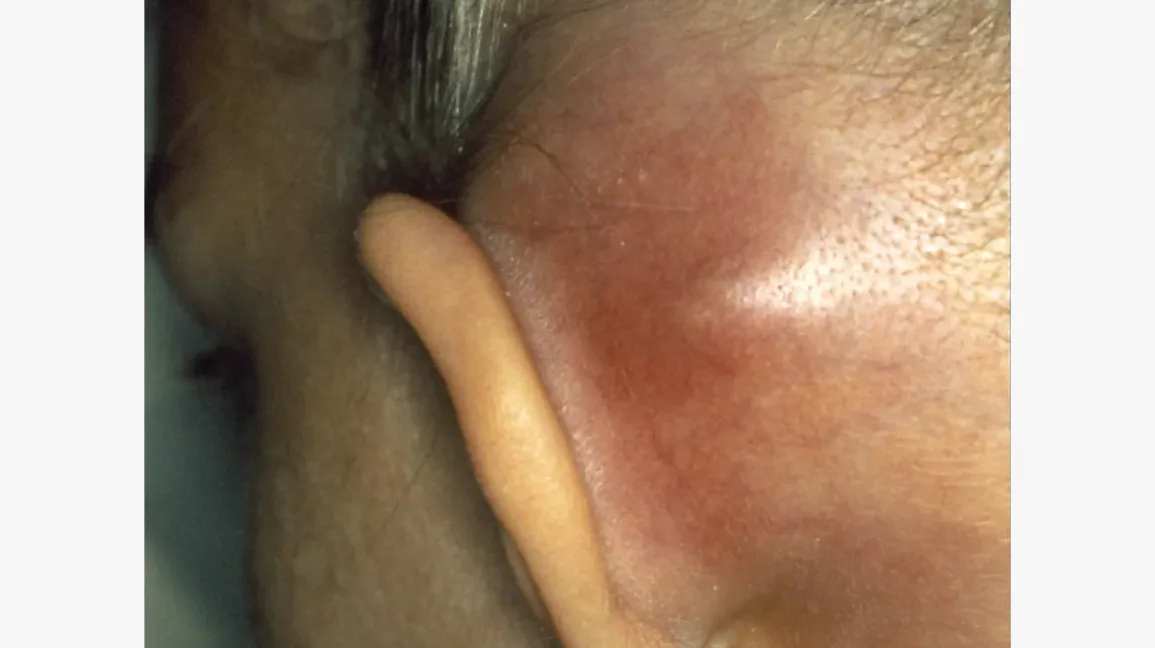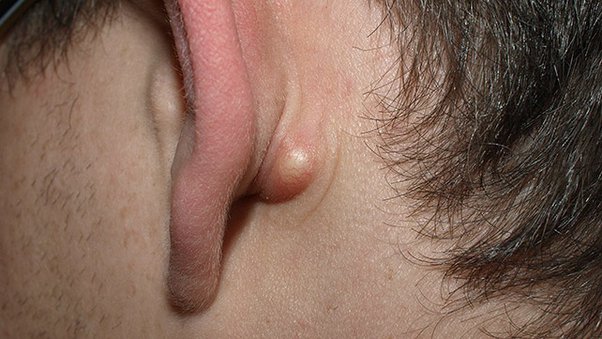Discovering a lump behind your ear can be unsettling, but it’s essential to understand that such lumps can have a variety of causes, many of which are benign. Recognizing the potential causes and symptoms of a lump behind ear is crucial for determining when to seek medical advice and identifying appropriate treatments.
In this article, we will delve into the various causes of lumps behind the ear, ranging from infections and skin conditions to more serious issues like mastoiditis and cancerous tumors. We will also discuss the symptoms to watch for, the diagnostic process, treatment options, home remedies, and preventive measures to help you manage this condition effectively. Knowing what your symptoms are and when to get expert assistance can help you maintain your health and peace of mind, regardless of whether you’re dealing with a minor annoyance or something more serious.
Table of Contents
ToggleWhat is a Lump Behind the Ear?
A lump behind ear refers to any swelling or localized protrusion that develops in the area directly behind the ear. These lumps can vary in size, consistency, and cause, ranging from benign conditions to more serious health issues. Understanding the potential causes and symptoms of a lump behind ear is crucial for determining when medical advice should be sought and for identifying appropriate treatments.
Identifying the underlying causes of a lump behind ear is essential for proper management and treatment. While many lumps are harmless and may resolve on their own, others may indicate a more serious condition that requires medical intervention. Recognizing when a lump behind ear warrants professional evaluation can lead to timely and effective care, potentially preventing complications. In this article, we will explore the various causes, symptoms, and treatments of a lump behind ear, and highlight when it is important to be concerned and seek medical advice.
What Causes a Lump Behind the Ear?

A lump behind ear can arise due to a variety of reasons, each with its own set of characteristics and implications. Identifying the cause is essential for determining the appropriate treatment and understanding whether the lump poses a serious health risk. Here, we explore the common causes of a lump behind ear.
Infections
Infections are a frequent cause of a lump behind ear. They can lead to swelling in the lymph nodes or directly affect the area behind the ear. Common infections include:
- Ear Infections: Otitis media (middle ear infection) or otitis externa (outer ear infection) can cause swelling and the development of a lump behind ear.
- Colds and Flu: Viral infections such as colds and the flu often lead to swollen lymph nodes, which can manifest as a lump behind ear.
- Strep Throat: This bacterial infection can cause the lymph nodes behind the ear to swell, resulting in a noticeable lump.
- Respiratory Infections: Infections of the upper respiratory tract can also cause lymph node swelling behind the ear.
Skin Conditions
Several skin conditions can lead to the formation of a lump behind ear. These conditions typically involve inflammation or blockages in the skin’s glands and follicles:
- Acne: Blocked hair follicles and oil glands can lead to pimples or cysts behind the ear.
- Sebaceous Cysts: These are non-cancerous, fluid-filled lumps that develop from blocked sebaceous glands. They are common causes of a lump behind ear.
- Dermatitis: Skin inflammation due to dermatitis can lead to swelling and the development of lumps in various areas, including behind the ear.
Swollen Lymph Nodes
Swollen lymph nodes, or lymphadenopathy, often cause lumps behind the ear. Lymph nodes can swell due to various reasons, including:
- Infections: Both viral and bacterial infections can cause the lymph nodes to enlarge.
- Inflammation: Conditions such as rheumatoid arthritis or lupus can lead to swollen lymph nodes.
- Dental Issues: Infections or abscesses in the teeth or gums can also cause lymph nodes behind the ear to swell.
Benign Growths
Benign growths are non-cancerous lumps that can form behind the ear. These growths include:
- Lipomas: Soft, fatty lumps that are usually harmless and slow-growing.
- Keloids: Raised, thickened areas of scar tissue that can develop after an injury or surgery.
Each of these causes presents differently and may require specific treatments. If you notice a lump behind ear, it is important to monitor its characteristics and consult a healthcare provider if it persists or causes concern.
Serious Causes of a Lump Behind the Ear
While many causes of a lump behind ear are benign and resolve on their own, some conditions are more serious and require immediate medical attention. Two of the most concerning causes are mastoiditis and cancerous tumors.
Mastoiditis
What is Mastoiditis?
Mastoiditis is an infection of the mastoid bone, which is located just behind the ear. This condition occurs when a middle ear infection spreads to the mastoid bone, causing inflammation and the formation of a lump behind ear.
Symptoms of Mastoiditis
The symptoms of mastoiditis can be severe and may include:
- Intense pain and tenderness behind the ear
- Swelling and redness in the affected area
- Fever and chills
- Discharge from the ear
- Hearing loss in the affected ear
- Headache
Importance of Immediate Medical Treatment
Mastoiditis is a serious condition that requires prompt medical treatment to prevent complications such as hearing loss, the spread of infection to the brain, or the formation of abscesses. If you suspect mastoiditis as the cause of a lump behind ear, seek immediate medical attention.
Cancerous Tumors
Types of Cancer that Can Cause Lumps Behind the Ear
Several types of cancer can present as a lump behind ear, including:
- Skin Cancer: Basal cell carcinoma, squamous cell carcinoma, and melanoma can develop behind the ear.
- Lymphoma: This type of cancer affects the lymphatic system and can cause lymph nodes behind the ear to swell.
- Salivary Gland Cancer: Although rare, tumors in the salivary glands can manifest as lumps near the ear.
Characteristics of Cancerous Lumps
Cancerous lumps typically have distinct characteristics that differentiate them from benign lumps:
- Hard and immovable upon palpation
- Irregular shape and uneven borders
- Rapid growth over a short period
- Painless in the early stages but may become painful as the tumor grows
Diagnostic Process for Cancerous Lumps
If a lump behind ear is suspected to be cancerous, a thorough diagnostic process is necessary. This may include:
- Physical Examination: Initial assessment by a healthcare provider.
- Imaging Studies: Ultrasound, CT scans, or MRI to visualize the lump.
- Biopsy: A sample of the lump is taken and analyzed for cancer cells.
- Blood Tests: To check for markers indicative of cancer.
Early detection and diagnosis are critical for effective treatment of cancerous lumps behind the ear. If you notice a lump behind ear that exhibits these characteristics, it is important to consult a healthcare professional promptly.
Symptoms to Watch For

General Symptoms
When evaluating a lump behind ear, several general symptoms can indicate the nature and severity of the condition. These symptoms include:
- Pain: Pain may be sharp or dull and can vary in intensity. It often indicates inflammation or infection.
- Tenderness: The area around the lump behind ear may be sensitive to touch, suggesting an underlying issue such as an infection or cyst.
- Swelling: Swelling can accompany the lump, indicating inflammation or fluid accumulation in the area.
- Redness: Redness around the lump often signifies infection or irritation of the skin.
When to Seek Medical Advice
It is important to recognize when a lump behind ear necessitates medical evaluation. Specific circumstances warranting professional consultation include:
- Lump remains unchanged after 2-3 weeks: If a lump behind ear persists without improvement, it may indicate a chronic issue requiring further investigation.
- Lump is painful or oozing: Painful lumps or those that discharge pus or other fluids suggest infection or other serious conditions.
- Lump appears suddenly: A lump behind ear that emerges abruptly could be due to an acute infection or injury.
- Lump increases in size or shape: Rapid growth of a lump is concerning and should be assessed by a healthcare provider to rule out malignancies or aggressive infections.
- Lump does not move or is fixed: A fixed or immovable lump might be attached to underlying structures, raising the possibility of malignancy.
- Accompanying symptoms: fever, malaise, weight loss: Systemic symptoms like fever, generalized malaise, or unexplained weight loss in conjunction with a lump behind ear can signal serious conditions such as systemic infections or cancer.
Monitoring these symptoms and seeking timely medical advice ensures proper diagnosis and treatment, which is critical for managing the underlying cause of a lump behind ear effectively.
Diagnosis of a Lump Behind the Ear
Diagnosing a lump behind ear involves a thorough clinical evaluation and a series of diagnostic tests to determine the underlying cause. This process is crucial for formulating an appropriate treatment plan.
Initial Examination
Physical Examination
The initial step in diagnosing a lump behind ear is a comprehensive physical examination. A healthcare provider will inspect the lump, noting its size, shape, consistency, and mobility. They will also check for signs of infection, such as redness, warmth, and tenderness. Palpation of nearby lymph nodes and structures helps to assess if the lump is part of a larger systemic issue.
Medical History Review
A thorough review of the patient’s medical history is necessary for diagnosis. The healthcare provider will inquire about the duration of the lump behind ear, associated symptoms (such as pain, fever, or weight loss), recent infections, and any history of similar lumps. They will also consider personal and family medical history, which can provide clues about genetic predispositions to certain conditions, including cancers.
Diagnostic Tests
Blood Tests
Blood tests can provide valuable information about the underlying cause of a lump behind ear. These tests may include:
- Complete Blood Count (CBC): This test helps to identify infections, anemia, and hematological conditions by measuring different components of the blood.
- Inflammatory Markers: Tests such as C-reactive protein (CRP) and erythrocyte sedimentation rate (ESR) can indicate the presence of inflammation or infection.
Ultrasound
An ultrasound is a non-invasive imaging technique that uses sound waves to create detailed images of the structures behind the ear. It can help differentiate between cysts, solid masses, and swollen lymph nodes, providing essential information about the nature of the lump behind ear.
Biopsy
A biopsy involves taking a small sample of tissue from the lump behind ear for microscopic examination. This procedure is critical for diagnosing or ruling out cancer. Depending on the lump’s characteristics, different biopsy techniques may be used, including fine-needle aspiration, core needle biopsy, or excisional biopsy.
CT Scan
A CT scan (computed tomography) provides detailed cross-sectional images of the head and neck, offering a comprehensive view of the lump behind ear and surrounding tissues. This imaging modality is particularly useful for assessing the extent of any tumors and planning further treatment if malignancy is suspected.
These diagnostic steps are vital for accurately identifying the cause of a lump behind ear and guiding the appropriate therapeutic approach.
Treatment Options for a Lump Behind the Ear

Treatment for a lump behind ear depends on the underlying cause. Here, we outline various treatment options based on the different causes of such lumps.
Treatment for Infections
Antibiotics
For bacterial infections causing a lump behind ear, antibiotics are often prescribed. These can effectively treat conditions such as ear infections, strep throat, and mastoiditis. The specific antibiotic used will depend on the type of bacteria and the patient’s medical history.
Over-the-Counter Pain Medications
Pain and inflammation associated with infections can be managed with over-the-counter pain medications like ibuprofen or acetaminophen. These medications help reduce discomfort while the underlying infection is being treated.
Treatment for Skin Conditions
Topical Creams for Acne
For lumps caused by acne, topical treatments containing benzoyl peroxide, salicylic acid, or retinoids can be effective. These agents help reduce inflammation, clear blocked pores, and prevent future breakouts behind the ear.
Lotions and Antifungal Agents for Dermatitis
Dermatitis, including seborrheic dermatitis and contact dermatitis, can cause lumps behind the ear. Treatment often involves the use of topical corticosteroids or antifungal creams to reduce inflammation and treat any underlying fungal infections.
Treatment for Swollen Lymph Nodes
Treating the Underlying Cause
Swollen lymph nodes causing a lump behind ear often resolve once the underlying infection or condition is treated. Addressing the root cause—such as a dental abscess or a respiratory infection—will help reduce the swelling of the lymph nodes.
Possible Use of Antibiotics or Biopsy
If the swollen lymph nodes are due to a bacterial infection, antibiotics may be necessary. In cases where the cause is unclear, a biopsy might be performed to rule out malignancies or other serious conditions.
Treatment for Benign Growths
Surgical Removal of Lipomas and Cysts
Benign growths such as lipomas and sebaceous cysts behind the ear may require surgical removal if they cause discomfort, become infected, or grow significantly. The procedure is usually simple and performed under local anesthesia.
Treatment for Serious Conditions
Immediate Antibiotics or Surgery for Mastoiditis
Mastoiditis is a serious infection that requires prompt treatment. Immediate antibiotics are administered to control the infection, and in severe cases, surgery may be necessary to drain the mastoid bone and prevent further complications.
Chemotherapy or Radiation for Malignant Tumors
Cancerous lumps behind the ear necessitate specialized treatments depending on the type and stage of cancer. Treatment options include chemotherapy, radiation therapy, and surgical removal of the tumor. Early detection and a tailored treatment plan are crucial for the best outcomes.
Each treatment approach aims to address the specific cause of the lump behind ear, ensuring effective management and relief of symptoms.
Home Remedies and Self-Care
For those dealing with a lump behind ear, certain home remedies and self-care practices can help alleviate symptoms, especially when the condition is mild. However, it’s important to recognize when professional medical advice is needed.
Home Remedies for Mild Conditions
Warm Compresses
Applying a warm compress to the lump behind ear can help reduce pain and swelling. The warmth increases blood circulation to the area, promoting healing and relieving discomfort. Use a clean cloth soaked in warm water and apply it to the affected area for 10-15 minutes several times a day.
Over-the-Counter Pain Relief
Over-the-counter pain medications such as ibuprofen or acetaminophen can be effective in managing pain and reducing inflammation associated with a lump behind ear. These medications help alleviate symptoms while the underlying cause resolves.
Maintaining Hygiene
Maintaining good hygiene is crucial, especially if the lump behind ear is caused by skin conditions such as acne or dermatitis. Regularly cleaning the area with gentle soap and water can prevent infections and help manage existing conditions. Steer clear of harsh chemicals and excessive scouring of the area.
When Home Remedies Are Not Enough

Importance of Consulting a Healthcare Provider for Persistent or Severe Symptoms
While home remedies can be helpful for minor issues, they are not always sufficient. Seeking advice from a healthcare professional is crucial if:
- The lump behind ear persists for more than a few weeks without improvement.
- The lump becomes increasingly painful or starts to ooze.
- The lump grows rapidly or changes in shape.
- There are additional symptoms such as fever, unexplained weight loss, or overall malaise.
Seeking professional medical advice ensures that any serious underlying conditions are promptly identified and treated, preventing potential complications and promoting better health outcomes.
Prevention Tips

Preventing a lump behind ear involves maintaining good hygiene, addressing potential sources of infection promptly, and keeping up with regular health checkups. Here are some effective strategies to minimize the risk of developing lumps behind the ear.
General Ear Care
Keeping Ears Clean and Dry
Proper ear hygiene is essential in preventing conditions that can lead to a lump behind ear. Regularly clean the ears with a gentle, non-abrasive cleanser. Avoid inserting objects like cotton swabs deeply into the ear canal, as this can cause irritation or push wax deeper. After swimming or bathing, ensure that ears are thoroughly dried to prevent moisture build-up, which can lead to infections.
Avoiding Irritants and Allergens
To prevent skin conditions and allergic reactions that may result in a lump behind ear, avoid known irritants and allergens. Use hypoallergenic products and avoid harsh chemicals on the skin around the ears. Wearing protective gear in environments with high exposure to dust, chemicals, or other allergens can also help.
Preventing Infections
Proper Treatment of Ear Infections and Colds
Promptly treating ear infections and upper respiratory infections like colds is crucial. Infections can spread to the areas behind the ear, causing swollen lymph nodes and lumps. Follow prescribed treatments and complete the full course of antibiotics if prescribed to ensure infections are fully resolved.
Good Dental Hygiene to Prevent Dental Infections
Maintaining good dental hygiene helps prevent dental infections that can cause lymph node swelling behind the ear. Brush and floss daily, and visit a dentist regularly for checkups and cleanings. Addressing dental issues promptly can prevent infections from spreading and causing secondary complications.
Regular Health Checkups
Importance of Routine Medical Checkups
Regular medical checkups are vital for early detection and prevention of health issues that can cause a lump behind ear. Routine visits allow healthcare providers to identify and treat potential problems before they become serious.
Early Detection of Potential Issues
Early detection of health issues, such as infections or skin conditions, can prevent complications that lead to lumps behind the ear. Regular screenings and prompt attention to unusual symptoms help maintain overall health and well-being.
Implementing these prevention tips can significantly reduce the risk of developing a lump behind ear, ensuring better ear health and overall wellness.
Frequently Asked Questions (FAQs)
Can a Lump Behind the Ear Be Cancer?
Understanding the Likelihood and Signs
While a lump behind ear can sometimes be cancerous, most lumps are benign. Cancerous lumps tend to be hard, immovable, and may grow rapidly. They are often painless in the early stages but can become painful as they grow. Types of cancer that can cause a lump behind ear include lymphoma, skin cancer, and salivary gland cancer. If a lump exhibits any suspicious characteristics or is accompanied by systemic symptoms like unexplained weight loss or persistent fatigue, it is crucial to seek medical evaluation.
How Long Do Lumps Behind the Ear Last?
Typical Duration Based on Cause
The duration of a lump behind ear largely depends on its underlying cause:
- Infections: Lumps due to infections like ear infections or colds typically resolve within a few days to a couple of weeks once the infection is treated.
- Skin Conditions: Acne or sebaceous cysts may persist longer but often improve with appropriate skin care and treatment.
- Swollen Lymph Nodes: These lumps generally subside within a few weeks once the underlying infection or inflammation is resolved.
- Benign Growths: Lipomas and other benign tumors may remain for years unless surgically removed.
Is a Lump Behind Ear Dangerous?
When to Be Concerned
A lump behind ear is not always dangerous, but certain signs indicate the need for medical attention:
- The lump does not improve or change after 2-3 weeks.
- It is painful, growing, or fixed in place.
- It is accompanied by systemic symptoms like fever, night sweats, or weight loss.
- The lump appears suddenly or changes rapidly.
Consulting a healthcare provider can help determine the seriousness of the lump and the appropriate course of action.
How Can I Prevent Lumps Behind the Ear?
Practical Tips and Preventive Measures
Preventing a lump behind ear involves:
- Maintaining good ear hygiene: Regular cleaning and keeping ears dry.
- Avoiding irritants: Using hypoallergenic products and avoiding known allergens.
- Promptly treating infections: Addressing ear infections, colds, and dental issues quickly.
- Regular checkups: Routine visits to healthcare providers for early detection and management of potential problems.
What Should I Do if a Lump Behind My Ear Hurts?
How to Proceed and When to Consult a Physician
If a lump behind ear is painful:
- Apply warm compresses to reduce discomfort.
- For pain relief, use over-the-counter medications such ibuprofen or acetaminophen.
- Maintain cleanliness around the area to prevent infection.
Seek medical advice if the pain persists, the lump grows, or other concerning symptoms develop. Early diagnosis and treatment planning might be aided by consultation.
Conclusion

Recap of Key Points
Understanding the potential causes of a lump behind ear is essential for proper management and treatment. While many lumps are benign and resolve on their own, some conditions require medical attention. Recognizing the symptoms and knowing when to seek medical advice can help ensure timely and effective treatment. The majority of lumps behind the ear are non-threatening, which provides reassurance. However, awareness and vigilance are crucial to addressing any serious underlying issues promptly.
Encouragement to Seek Medical Attention
If you notice a lump behind ear that persists, causes discomfort, or is accompanied by other concerning symptoms, it is important to seek professional medical advice. A healthcare provider can provide an accurate diagnosis and recommend appropriate treatment, ensuring the best possible outcome for your health. Early detection and intervention are key to managing any potential risks associated with a lump behind ear.
Stay Informed
Staying informed about ear health and related conditions can help you recognize potential issues early and take appropriate action. Continue learning about topics such as ear infections, skin conditions, and swollen lymph nodes to maintain your overall health and well-being. Knowledge empowers you to make better health decisions.
Read Also:
-
Sperm Cramps: Causes, Symptoms, Diagnosis, and Effective Treatment Options
-
Degloved Face: Causes, Symptoms, Effective Treatment Options, and Recovery
-
10 Proven Tips to Manage Stomach Flu Effectively: Essential Information and Symptoms Guide
Share Your Experience
Please feel free to express your thoughts and inquiries in the space provided for comments below. Your insights and inquiries can provide valuable information to others who might be dealing with similar concerns. Engaging in discussions can foster a supportive community and promote better understanding of health issues.
1 thought on “Lump Behind Ear: Causes, Symptoms, When To Be Concerned, And Effective Treatments”
Very interesting details you have noted, thanks for posting.Raise blog range